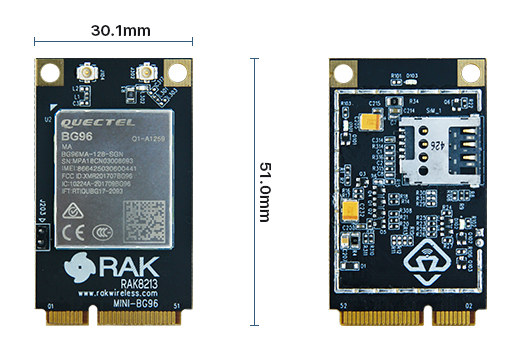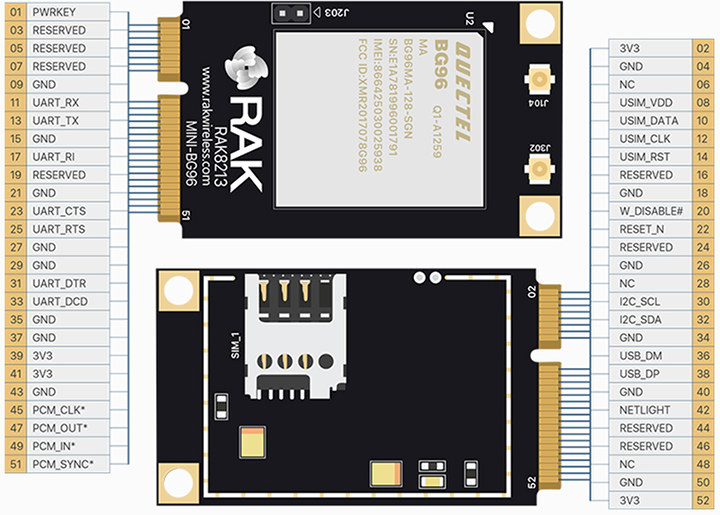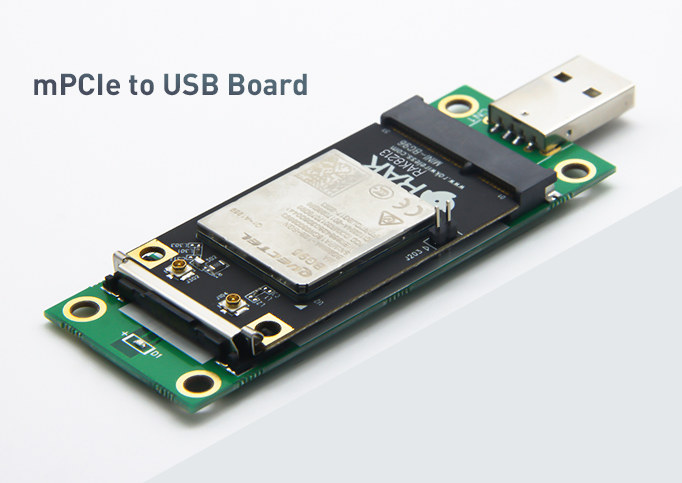After launching their first wireless communication mini PCIe card with RAK833 LoRaWAN gateway card last month, RAK Wireless is back with another mPCIe card that supports GNSS (GPS, GLONASS), as well as cellular IoT connectivity thanks to Quectel BG96 NB-IoT + LTE Cat M1 module.
 RAK8213 mini PCIe card specifications:
RAK8213 mini PCIe card specifications:
- Wireless Connectivity
- Module – Quectel BG96 with LTE Cat. M1 (eMTC), LTE Cat. NB1 (NB-IoT), EGPRS, and GNSS
- Global bands support
- FDD-LTE – B1/ B2/ B3/ B4/ B5/ B8/ B12/ B13/ B18/
B19/ B20/ B26/ B28 - TDD-LTE – B39 (for Cat M1 only)
- EGPRS – 850/900/1800/1900Mhz
- FDD-LTE – B1/ B2/ B3/ B4/ B5/ B8/ B12/ B13/ B18/
- Max Data Rate – Cat M1: 375 kbps (UL/DL); Cat NB1: 32 kbps DK, 70 kbps (UL)
- micro SIM slot
- u.FL connectors for cellular and GNSS
- mPCIe connector with USB 2.0, I2C, UART, and PCM
- Misc – LEDs for network and power status
- Dimensions – 51 x 30.1 mm
The card can be added to netbooks/notebooks or routers with mPCIe socket, used for remote monitoring, smart meter reading, and so on. You’ll find hardware (datasheet + schematics) and software (user manual) documentation in the relevant “document download” page. The user manual basically explains how you can send AT commands over USB or UART to the card in Windows, and how to setup the board with Hologram IoT SIM card.
RAK8213 mPCIe card is sold for $39.99 plus shipping on Aliexpress, and optional accessories are also offered namely a USB to mPCIe board for $10, and a Hologram SIM card for $7.
RAK8213 is not the first NB-IoT/eMTC mPCIe card on the market, as you’ll also find some based on SIMCom SIM7000 module for about $30 shipped. However, bear in mind that contrary to RAK8213 which works globally, SIM7000A / SIM7000C / SIM7000E work in specific regions, namely America, China and Europe. SIM7000G is the global version, but I could not find mini PCIe card based on that module.

Jean-Luc started CNX Software in 2010 as a part-time endeavor, before quitting his job as a software engineering manager, and starting to write daily news, and reviews full time later in 2011.
Support CNX Software! Donate via cryptocurrencies, become a Patron on Patreon, or purchase goods on Amazon or Aliexpress







Has anyone ever seen WiFi+BT+GPS miniPCIe combo card?
Looking at the specs, it seems that the power consumption in Cat.NB1 are too similar to Cat.M1 , sometimes bigger. This is not a nice aspect for this board: for NB-IoT objects we expect lower consumption in order to enlarge battery life. Consider that having in NB-IoT a very low transfer rate (32Kbps in download, 70Kbps in upload) rather than in Cat.M1 mode (375Kbps in both UP/DL) we expect much lower consumption; comparing standby power in i/e-DRX modes (5mA for Cat.M1, 15mA in Cat.NB1) and sleep power (1.1mA in Cat.M1, 1.7mA in Cat.NB1) we’ve a bigger power consumption in Cat.NB1, and this sound really unexpected, many use cases for NB-IoT cannot be implemented with this.
Where are you getting these numbers from?
The datasheet doesn’t show any power consumption values for NB1.
He must have found it in BG96 datasheet:
Consumption @LTE Cat M1 (Typical):
Power Saving Mode: 10uA
Standby State:
16mA @DRX=1.28s
15mA @e-I-DRX=20.48s
Sleep State:
1.7mA @DRX=1.28s
1.1mA @e-I-DRX=20.48s
LTE Connected Mode (Avg.):
124mA @0dBm
130mA @10dBm
190mA @23dBm
Consumption @LTE Cat NB1 (Typical):
Power Saving Mode: 10uA
Standby State: 16mA @DRX=1.28s
15mA @e-I-DRX=20.48s
Sleep State:
2.3mA @DRX=1.28s
1.7mA @e-I-DRX=20.48s
LTE Connected Mode (Avg.):
65mA @0dBm
66mA @10dBm
78mA @23dBm
Thanks for that. It does show a difference from Gaetano’s numbers (both modes require 15mA standby).
Those values are not amazing, but even at 1.1mA I wouldn’t be using sleep mode – I’d be keeping an NB1 device in power saving mode most of the time.
1/2 the instantaneous demand is quite a big difference if you’re running on battery or solar.